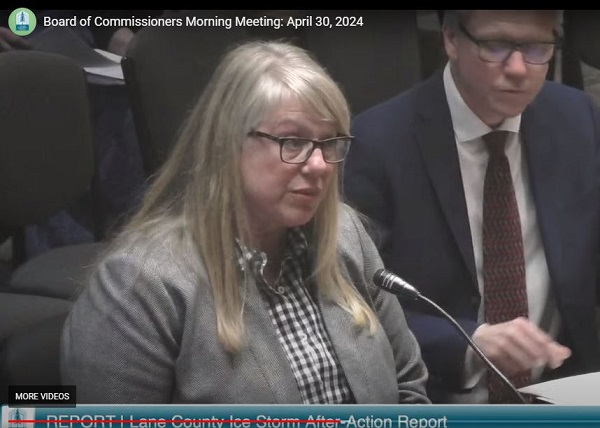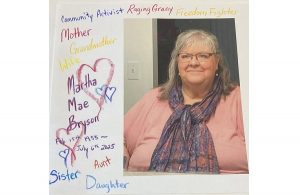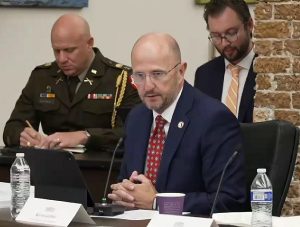After ice storm, Lane County to improve alerts, mass care, training
10 min read
Lane County’s new emergency manager shares her hot wash report on the January ice storm. With the county commissioners April 30:
Tiffany Brown (Lane County, emergency manager): So what’s a hot wash? A regular word for a hot wash would be a debrief of the incident and a discussion. It’s ‘Whole Community’ involvement; this is an emergency management term that means inclusion and equity—that everyone who has a voice, everyone who has a stake in the project or the process or the policy or procedure is at the table to discuss that.
[00:00:32] We focus on the objectives, where we’re trying to get; what we’ve already done in terms of identifying gaps; and areas of improvement. We try to encourage a no-blame environment so that when we get there, we raise the important issues and lessons, we identify the capability gaps, we start to talk about the solutions and at the end of it, I come to you today with a three high, three low outcome of that hot wash series.
[00:00:58] Part of that no-blame environment, looking forward, focusing on objectives, part of that is framing the questions in such a way that we’re able to roll it up. So what went well? Where were there opportunities for improvement? So here’s what we heard. Our successes:
- Operational communication. Some of the things that we have put into place as a result of the wildfire and increased hazard environment in Lane County are working.
- Operational coordination. We’ve made a number of improvements to the Emergency Operations Center and those things paid off. And then finally:
- Partnerships. The relationships that we’ve developed over the last few years come into play. They make things work more smoothly when the time comes. And we saw a state agency presence in our Emergency Operations Center during this event that was unprecedented. It was effective and it was really a shot in the arm for a short-staffed event.
[00:01:54] What we heard that was less successful:
- Communications and alerting. We sent one alert only during this event. And for a number of reasons I think we’re really well-tuned to notify during wildfire events. We know what we’re notifying and why; it’s about evacuation and resources. And we saw an opportunity to use that more robustly during the event. And what we’re talking about is really nothing complex, something as simple as, ‘We’re expecting ice, please try to stay home.’
Also, better public messaging across and situational awareness across agencies. Again, this is how do we build a more redundant system. We heard that there were different weather patterns in different parts of the county that caused confusion. We had people unaware because of the communication issues about what was going on. So we’ll be looking at how to harden that system, do a better job of gathering and disseminating situational awareness during an event. - We had staffing challenges. Everyone has staffing challenges. Every entity that we met with, they didn’t have a deep enough bench or they lacked staff for this event due to people not being able to get to work. One of the challenges was an inconsistent response and activation across agencies, ourselves included. Our interim emergency manager was isolated. He activated and operated from his home. It was an incredible effort. I listened to him present at the Oregon Prepared conference, and it was the best presentation I heard.
The cities, as we know, the city of Springfield devolved to the Emergency Operations Center with the county and the city of Eugene did not activate. However, they had staff represented in the EOC. I’m really proud that we had a bench and that we have a system that was able to scoop up that and work with our city partners. They don’t have a deep enough bench. We don’t have a deep enough bench. And so what an efficiency—maybe with all of the talk with budgets right now, if we couldn’t lean into those types of efficiencies moving forward for future events. - The final area that we identified over and over was insufficient planning, resources, equipment, facilities for mass care and human services. This was highlighted when our unhoused sheltering system was overwhelmed by folks being displaced as a result of the ice storm, ordinarily housed residents, and then the hospital releasing medically fragile people who didn’t have a place to go. So it highlighted that we lack shelter planning in other areas.
[00:04:42] I think this event really just highlighted the complexity of sheltering altogether. It also highlighted that it’s not a ‘this sheltering system’ or ‘this sheltering system,’ but that mass care for our residents is a comprehensive consideration.
[00:04:58] There was confusion about roles and responsibilities. Not necessarily for things that happen day to day, but: How do the roles and responsibilities for the Egan Warming Center, for example, change when they reach an emergency threshold? And then, how do we augment and look at building additional sheltering capacity so that that doesn’t happen again? I heard at the Egan listening session that St. Vincent de Paul is standing up an emergency response team. That tells me that they’re also identifying the need for thresholds.
[00:05:32] Identifying our top areas of improvement and our next steps for how we’ll address those: We need to perform an assessment and gap analysis of all emergency care resources. We realize when we start having these conversations, there are assumptions around mass care. One of them is that Red Cross will show up and take care of that. As a reminder, Red Cross typically is made up of those volunteers in your own community. And we don’t have many. And so, their bench is not deep. Remember I said it was everyone. It’s everyone.
[00:06:05] And so, how do we start having the conversation about roles and responsibilities and emergency thresholds? I think it’s by performing an assessment and a gap analysis. And having some sort of written records so that we are using the same words, talking about the same things, and that we all have a point of origin to start the discussion.
[00:06:27] Continued support of unhoused, emergency mass care, and resilience of resources. I was challenged by one of my colleagues to remove the word ‘continued.’ They said that we had not done enough in this area; I posit we have things moving in the right direction. But this is an area where you can continue to keep your eye on the ball and make sure that we continue to move things in that direction. We’re working on resilience hub resources at the operational level here in the county and we’re supporting all of these efforts.
[00:06:57] We will be expanding use of Lane Alerts with our internal partners, that’s employees as well as our external partners, those are our cooperators. Loading our Emergency Operation Center activation notice into the alerting system, making that really easy and flexible so that we can send it from anywhere, that it can go to a number of devices. And again, addressing those redundant communications, establishing thresholds for call center and alert activations. Tightening how we do those things, especially when we’re working across jurisdictions.
[00:07:32] And then performing public outreach regarding the alert system. As you know, we switched alert systems last year. You went from AlertSense to Everbridge and we have some work to do to put that in front of the public and help them understand how they opt in, how they use the system and how they can expect to hear from us using that system.
[00:07:54] The common theme through all of our partners—our sheltering partners, our utility partners, our public health and medical partners—was that they were unclear or unsure of how they tied into the Emergency Operations Center. So, we need to build out positions and programs, and create effective vectors, so that all those we serve during an emergency know how to get in touch with us and are able to do so easily.
[00:08:19] We need to identify funding sources and a process for emergency response at the outset of an incident. One of the things that we heard repeatedly was: ‘We were reluctant to respond. We weren’t sure who was paying for it. We didn’t know if it was going to be an emergency. Our leadership told us to hold off.’
[00:08:38] And we heard a lot of frustration around this, just not frustration with anyone in particular but the frustrated response of those on whom we rely to provide response that don’t feel like they have adequate resources or support to lean into an event when they see on the ground, the things that need to be addressed.
[00:09:00] And so, this is a conversation that’s happening at all levels of government. We need more help at the county level. And so whether that looks like legislative initiatives that are innovative and start looking at how counties are supported statewide through emergency management or whether we do what we do best and start looking at grassroots efforts and how we combine efforts and work together with our city and our special district partners during an event.
[00:09:29] And then finally, providing training programs, procedures, and policies that support employee response.
[00:09:35] But I think the point here is how this all sort of ties in together. What I haven’t listed here in terms of next steps is the suggested partnerships within the county that will get these work groups started.
[00:09:48] And here are our guiding principles: It is that ‘Whole Community’ connection. We will foster the existing and cultivate new relationships and we’ll ensure that everyone’s at the table that needs to be.
[00:09:59] Strategic and solution-focused: We need to look at these things through the lens of how everyone is affected; ensure that everyone is treated in an equitable manner, and has access to the resources and programs and is affected by the policies in the same way.
[00:10:15] And then stewardship of resources. I’ve talked to you a lot about not having a deep bench. But one of the other things I heard was, I think we had people available. We didn’t know how to plug in. We had staff that could help, but they were union members. We’re not really sure what that looks like. We heard a lot of good solutions from the community folks in the group about things they’d seen work in other places. And so I really look forward to both the ideas and then how we can come together collectively and find those efficiencies in a time of disaster.
[00:10:48] And finally, accountability. We’ll develop measurable impacts, focus on continuous improvement, and circle back to this group to talk about the progress that we’re making—at a time to be determined.
[00:11:02] Commissioner Heather Buch: You mentioned not having a deep bench…There’s two, maybe three humans to do all the work and I don’t know, frankly, I don’t know how we’re going to do that, because it is, a lot to work on for a county of our size to have two people, hopefully three people for incidents that are so huge and affect so many people in our community.
[00:11:26] Commissioner Pat Farr: …Red Cross is not going to be there and the federal government is not going to be there. So personal preparedness, the more we can do to help people have that food stored, have that water stored, and have a generation capacity.
[00:11:38] And as Chair (Laurie) Trieger pointed out, continue to support the unhoused. And not just the unhoused, but the people who are isolated in housing and are potentially going to feel like they’re unhoused during an emergency. So, making certain that we have as much in place to be responsive to those folks, including emergency mass care, including resilience hub centers.
[00:11:57] Commissioner David Loveall: I was just curious about partnering with schools and that sort of thing. Has there been any thought or discussion about emergency funds being partnered with maybe a large sports event-type center that would be located off I-5 that we could figure out a way that that would be resilient in all kinds of issues regardless of if the schools were in session or not?
[00:12:17] Commissioner Laurie Trieger: In an emergency, it lays bare the ongoing emergencies a lot of people in our county are experiencing—unhoused, medically fragile, remote from services. I know that was a real eye-opener for me when we had a fire event outside of Oakridge and a lot of folks evacuated and Commissioner Buch and I were touring the relief centers that we opened at Lane Event Center—just the physical medical condition of folks and how outdated their medical devices and equipment were and our facilities to meet their needs.
[00:12:47] So not only does your presentation give me great hope about our increasing capacity for emergency response, but also how much it’s informing our ability to get the resources we need for services to reduce the level of acuity and how many people are really suffering.
[00:13:01] And I also just want to point out our stalwart community volunteers, the Helmer family and folks that came today to listen in, and for all their ongoing support and advisement about what it’s like on the ground to be part of that mass care emergency sheltering at the community level. So thank you for that.
[00:13:17] John Q: After our latest disaster, Lane County’s new emergency manager describes the forward-looking ‘Whole Community‘ debriefing. Tiffany Brown said this event showed the need to focus on mass care, the new alert system, training, and familiarizing partners with the Emergency Operations Center. She plans a countywide assessment of emergency care resources, and straightforward guidance on when to activate.





